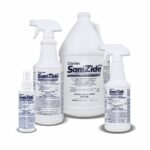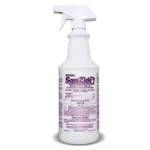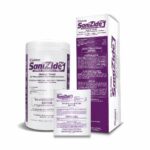
Route to Safety: Back to School Supplies, Part 2
The unprecedented reality that struck schools around the country when COVID-19 swept across the U.S. has parents and school officials alike trying to determine what the fall of 2021 will bring.
Reopening schools fully is a top priority for most K-12 schools around the country. As a result, superintendents, principals, SROs, teachers, and others will have to revaluate existing safety measures, including disinfection. Throughout the 2020-2021 school year, routine disinfection was a cornerstone of the COVID-19 mitigation strategy.
The CDC released an “Operational Strategy for K-12 Schools” that recommends mitigation strategies for K-12 schools based on current research. The strategies involve five key categories, one of which is cleaning and disinfection. Chances are, most schools will follow these protocols to limit spread as much as possible.
Cleaning and Disinfection
Cleaning with soap or detergent products reduces germs on surfaces by removing contaminants and decreasing infection risk.
Disinfecting (using U.S. Environmental Protection Agency (EPA)’s List N disinfectants) kills any remaining germs on surfaces, which further reduces any risk of spreading infection. The EPA’s List N specifies registered disinfectants approved for use against SARS-CoV-2.
When to Clean and Disinfect
The CDC recommends disinfecting (in addition to cleaning) more frequently in shared spaces or high-traffic areas. Moreover, if certain conditions apply, the risk of infection from surfaces increases, including:
- High transmission of COVID-19 in your community
- Low vaccination rates in your community
- Infrequent use of other prevention measures, such as mask-wearing
- Space is occupied by people with an increased risk for severe illness from COVID-19
Routine Cleaning and Disinfecting
Generally, the more people who touch a surface, the higher the risk. Therefore, prioritize cleaning high-touch surfaces at least once a day. However, if space is a high traffic area, or if certain conditions (listed above) apply, you may choose to clean more frequently or disinfect in addition to cleaning.
Implementation
Clean high-touch surfaces at least once a day or as often as determined is necessary. Examples of high-touch surfaces include pens, counters, shopping carts, tables, doorknobs, light switches, handles, stair rails, elevator buttons, desks, keyboards, phones, toilets, faucets, and sinks. Use a disinfectant product from the EPA List that is effective against COVID-19.
Always follow the directions on the label to ensure safe and effective use of the product. The label will include safety information and application instructions. For example, many products recommend keeping the surface wet with a disinfectant for a certain period (see “contact time” on the product label).
Made in America, for America
As schools reopen, now is the time to think about how best to keep our school buildings and classrooms clean and disinfected. Surface disinfecting wipes and sprays are important tools to help prevent the cross-contamination of germs like those that cause colds, flu, COVID-19, strep, and stomach bugs in schools.
As a U.S. infection control, first aid & OTC manufacturer, Safetec of America has been dedicated to leading the fight against preventable infections and cross-contamination for nearly 30 years. Safetec offers a line of surface products, including two EPA-registered disinfectant products, available in a liquid spray or wipes.
All Safetec disinfecting products are effective against SARS-CoV-2 (the virus that causes COVID-19), according to the emerging viral pathogen claim.
Sources:
https://www.cdc.gov/coronavirus/2019-ncov/community/disinfecting-building-facility.html
https://www.cdc.gov/coronavirus/2019-ncov/community/schools-childcare/operation-strategy.html#anchor_1616080023247




